072500 - Air / Vapor Barrier
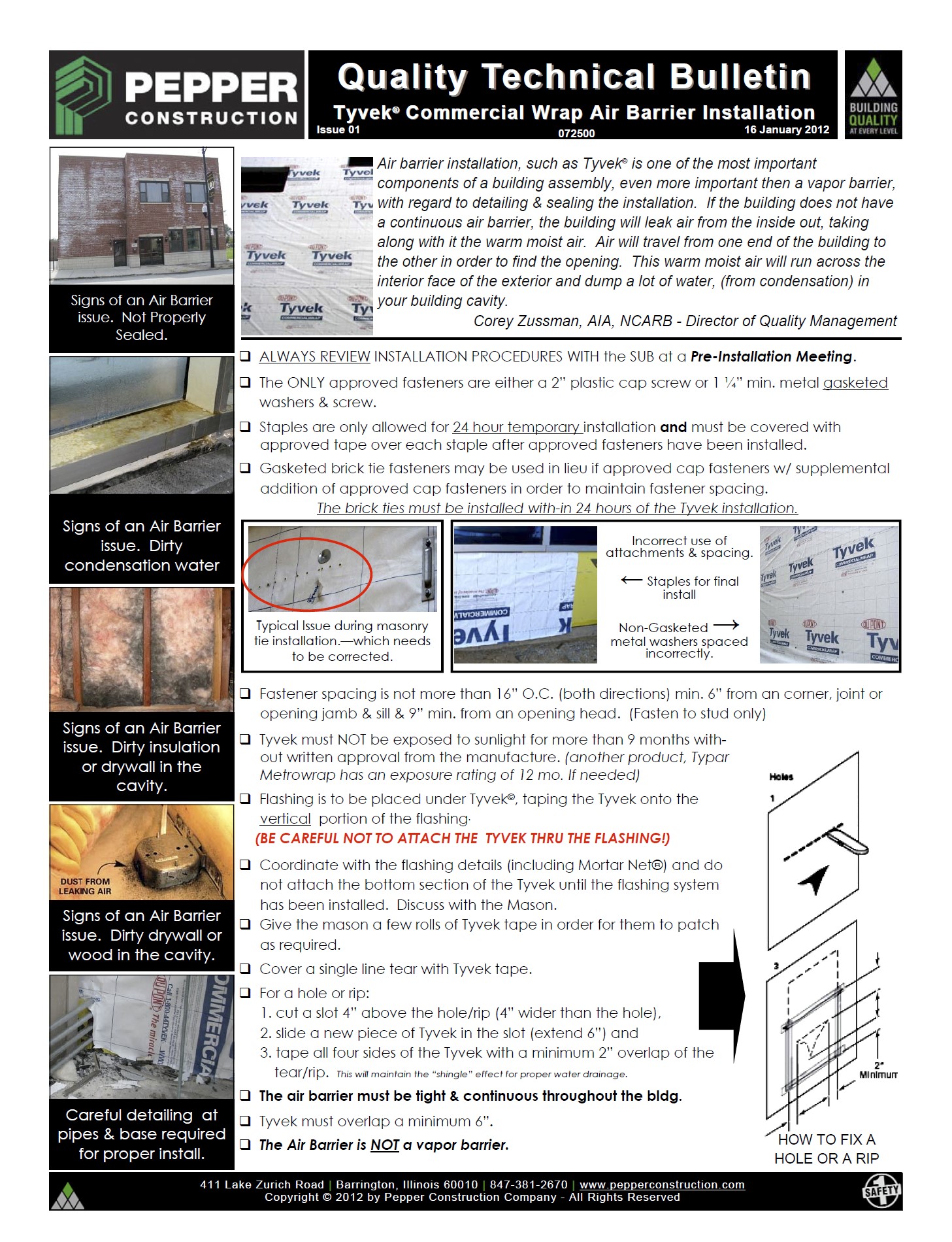
Tyvek Installation - Issue 01
- Corey S Zussman, AIA
- Link
Air barrier installation, such as Tyvek© is one of the most important components of a building assembly, even more important than a vapor barrier, with regard to detailing & sealing the installation. If the building does not havea continuous air barrier, the building will leak air from the inside out, takingalong with it the warm moist air. Air will travel from one end of the building to the other in order to find the opening. This warm moist air will run across the interior face of the exterior and dump a lot of water, (from condensation) in your building cavity.
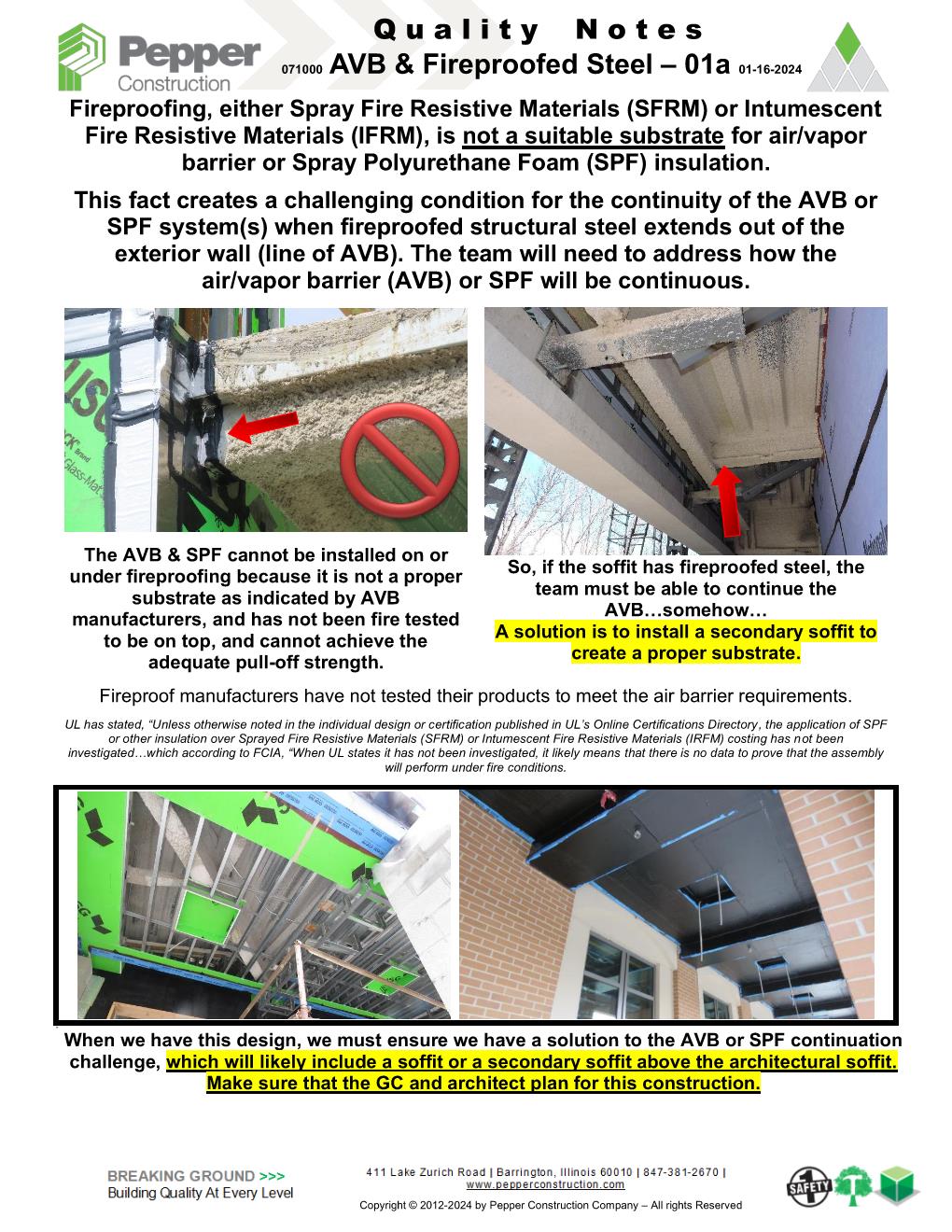
AV Barrier Fireproofing Steel in Soffit 01a - QN
- Corey S Zussman, AIA
- Link
Fireproofing, either Spray Fire Resistive Materials (SFRM) or Intumescent Fire Resistive Materials (IFRM), is not a suitable substrate for air/vapor barrier or Spray Polyurethane Foam (SPF) insulation. This fact creates a challenging condition for the continuity of the AVB or SPF system(s) when fireproofed structural steel extends out of the exterior wall (line of AVB). The team will need to address how the air/vapor barrier (AVB) or SPF will be continuous.
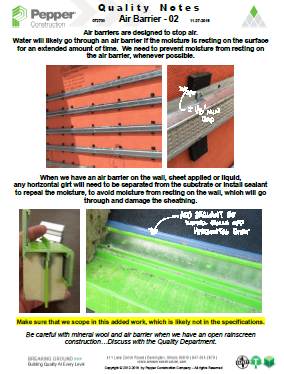
Air Barrier 02 Horizontal Girt - QN
- Corey S Zussman, AIA
- Link
Air barriers are designed to stop air. Water will likely go through an air barrier if the moisture is resting on the surface for an extended amount of time. We need to prevent moisture from resting on the air barrier, whenever possible.
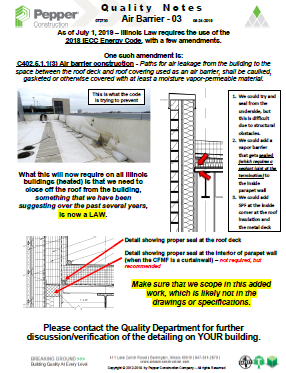
Air Barrier 04 Air Leaks and Roof - QN
- Corey S Zussman, AIA
- Link
Most air barriers REQUIRE that the roof or temporary roof be installed prior to the installation of the air barrier. Also note that the window opening should be protected from rain if the opening remains open for several weeks. We must coordinate the building progress with the air barrier installation requirement in mind.
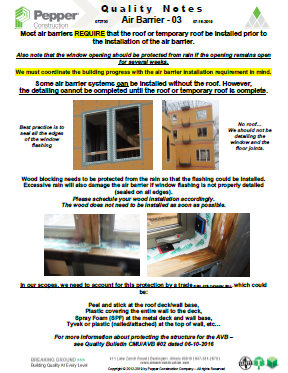
Air Barrier 03 Roof Requirements - QN
- Corey S Zussman, AIA
- Link
As of July 1, 2019 – Illinois Law requires the use of the 2018 IECC Energy Code, with a few amendments. One such amendment is: C402.5.1.1(3) Air barrier construction - Paths for air leakage from the building to the space between the roof deck and roof covering used as an air barrier, shall be caulked, gasketed or otherwise covered with at least a moisture vapor-permeable material.
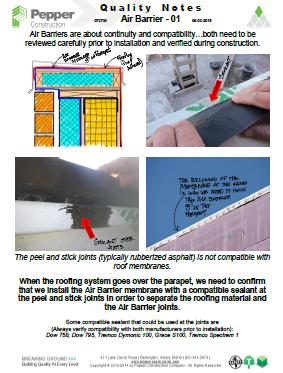
Air Barrier 01 Continuity Compatibility - QN
- Corey S Zussman, AIA
- Link
Air Barriers are about continuity and compatibility. Both need to be reviewed carefully prior to installation and verified during construction.
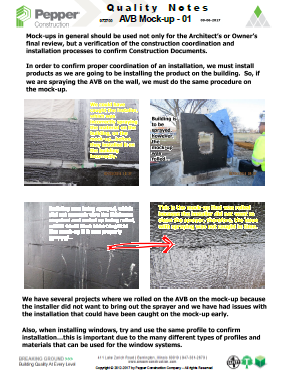
Air Barrier 01 Mockup - QN
- Corey S Zussman, AIA
- Link
Mock-ups in general should be used not only for the Architect’s or Owner’s final review, but a verification of the construction coordination and installation processes to confirm Construction Documents. In order to confirm proper coordination of an installation, we must install products as we are going to be installing the product on the building.
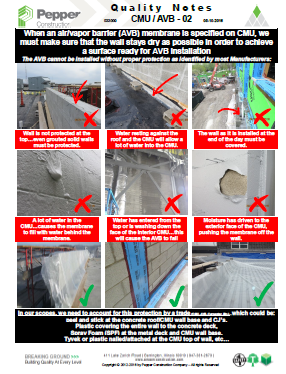
Air Barrier 02 CMU Protection for AVB Installation QN
- Corey S Zussman, AIA
- Link
When an air/vapor barrier (AVB) membrane is specified on CMU, we must make sure that the wall stays dry as possible in order to achieve a surface ready for AVB installation.
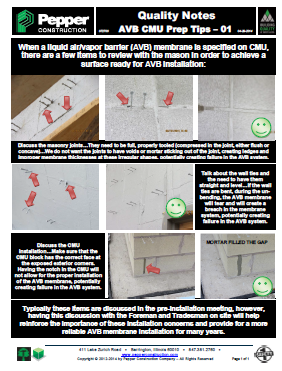
AV Barrier 01 CMU Prep Tips - QN
- Corey S Zussman, AIA
- Link
When a liquid air/vapor barrier (AVB) membrane is specified on CMU, there are a few items to review with the mason in order to achieve a surface ready for AVB installation.
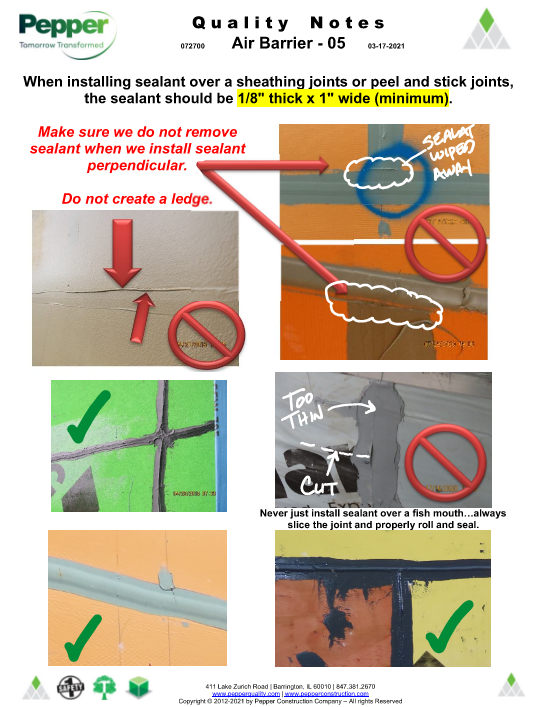
Air Barrier 05 Sealant Sheathing Joint - QN
- Corey S Zussman, AIA
- Link
When we need to treat the sheathing joints with sealant for the air barrier installation, we need to make sure that we have the correct thickness and width of the sealant. Failure to have the proper sealant installation will result in the failure of the system.
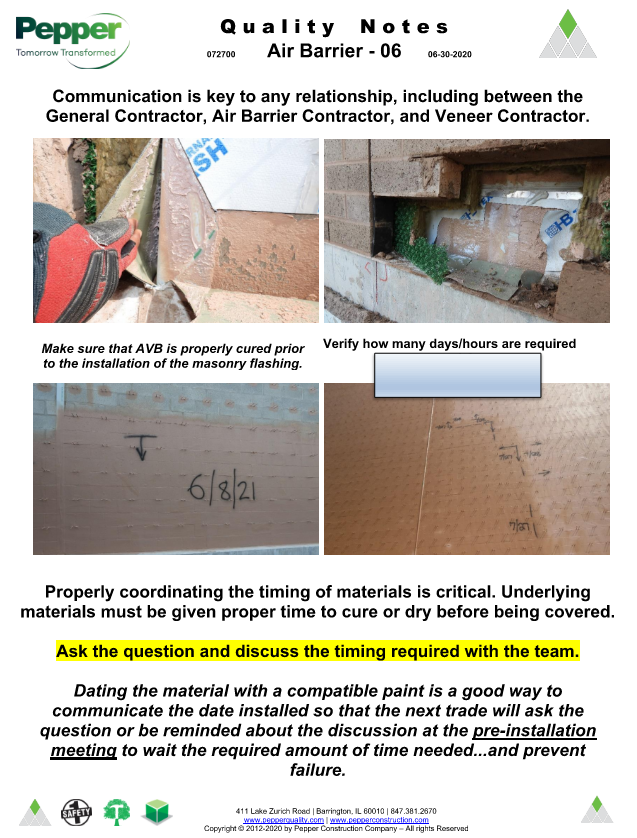
Air Barrier 06 Material Dating- QN
- Corey S Zussman, AIA
- Link
Communication is key to any relationship, including between the General Contractor, Air Barrier Contractor, and Veneer Contractor. Properly coordinating the timing of materials is critical. Underlying materials must be given proper time to cure or dry before being covered. Ask the question and discuss the timing required with the team. Dating the material with a compatible paint is a good way to communicate the date installed so that the next trade will ask the question or be reminded about the discussion at the pre-installation meeting to wait the required amount of time needed...and prevent failure.
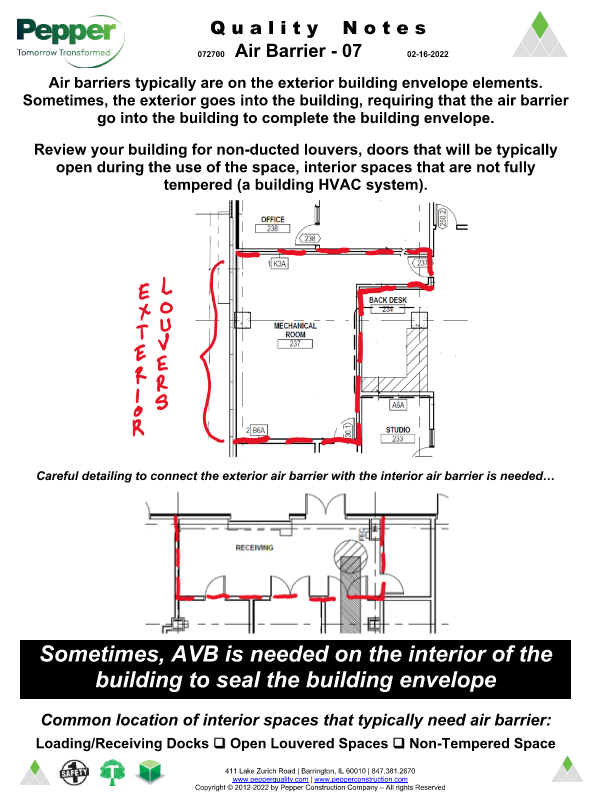
Air Barrier 07 Interior Air Barrier Installation- QN
- Corey S Zussman, AIA
- Link
Sometimes, AVB is needed on the interior of the building to seal the building envelope. Air barriers typically are on the exterior building envelope elements. Sometimes, the exterior goes into the building, requiring that the air barrier go into the building to complete the building envelope. Review your building for non-ducted louvers, doors that will be typically open during the use of the space, interior spaces that are not fully tempered (a building HVAC system).
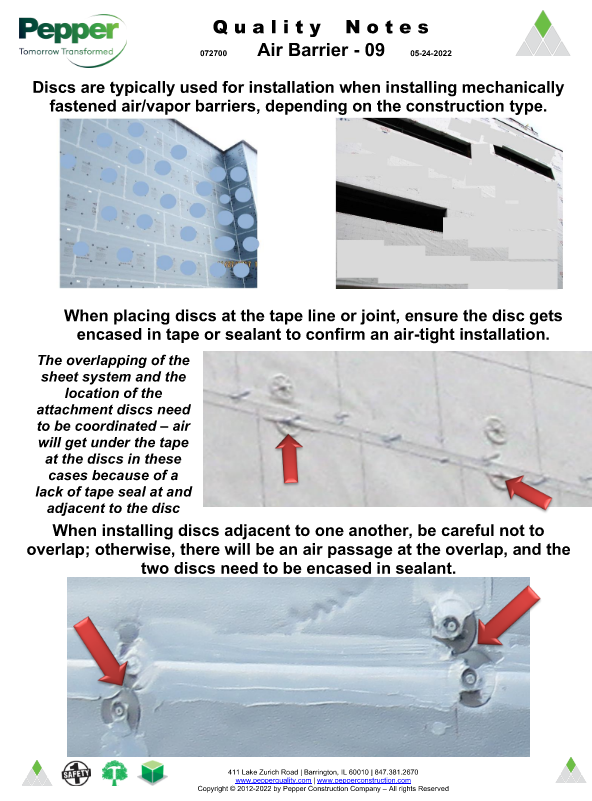
Air Barrier 09 Disc Installation - QN
- Corey S Zussman, AIA
- Link
Discs are typically used for installation when installing mechanically fastened air/vapor barriers, depending on the construction type. When placing discs at the tape line or joint, ensure the disc gets encased in tape or sealant to confirm an air-tight installation. When installing discs adjacent to one another, be careful not to overlap; otherwise, there will be an air passage at the overlap, and the two discs need to be encased in sealant.
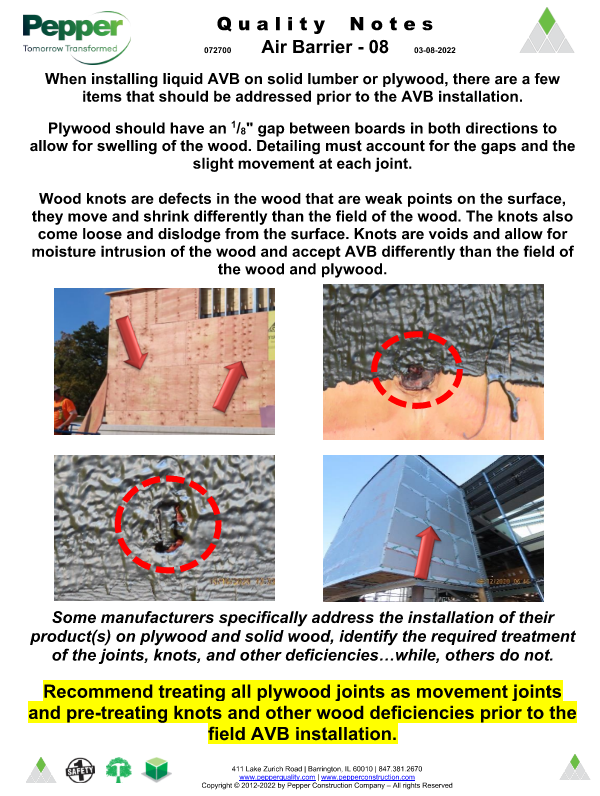
Air Barrier 08 Wood Knots - QN
- Corey S Zussman, AIA
- Link
When installing liquid AVB on solid lumber or plywood, there are a few items that should be addressed prior to the AVB installation. Plywood should have an 1/8" gap between boards in both directions to allow for swelling of the wood. Detailing must account for the gaps and the slight movement at each joint. Wood knots are defects in the wood that are weak points on the surface, they move and shrink differently than the field of the wood. The knots also come loose and dislodge from the surface. Knots are voids and allow for moisture intrusion of the wood and accept AVB differently than the field of the wood and plywood.
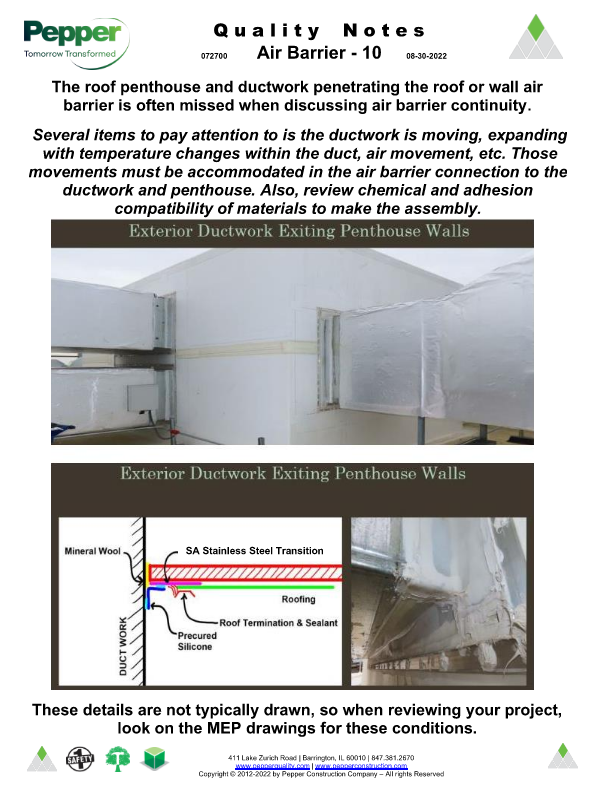
Air Barrier 10 HVAC Exterior Penetration Detailing - QN
- Corey S Zussman, AIA
- Link
The roof penthouse and ductwork penetrating the roof or wall air barrier is often missed when discussing air barrier continuity. Several items to pay attention to is the ductwork is moving, expanding with temperature changes within the duct, air movement, etc. Those movements must be accommodated in the air barrier connection to the ductwork and penthouse. Also, review chemical and adhesion compatibility of materials to make the assembly.
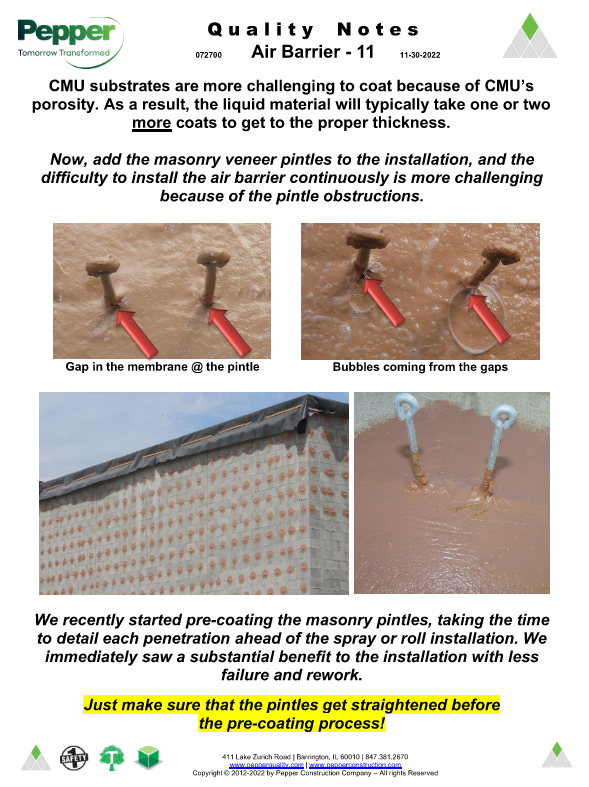
Air Barrier 11 CMU Pintle Detailing- QN
- Corey S Zussman, AIA
- Link
CMU substrates are more challenging to coat because of CMU’s porosity. As a result, the liquid material will typically take one or two more coats to get to the proper thickness. Now, add the masonry veneer pintles to the installation, and the difficulty to install the air barrier continuously is more challenging because of the pintle obstructions.
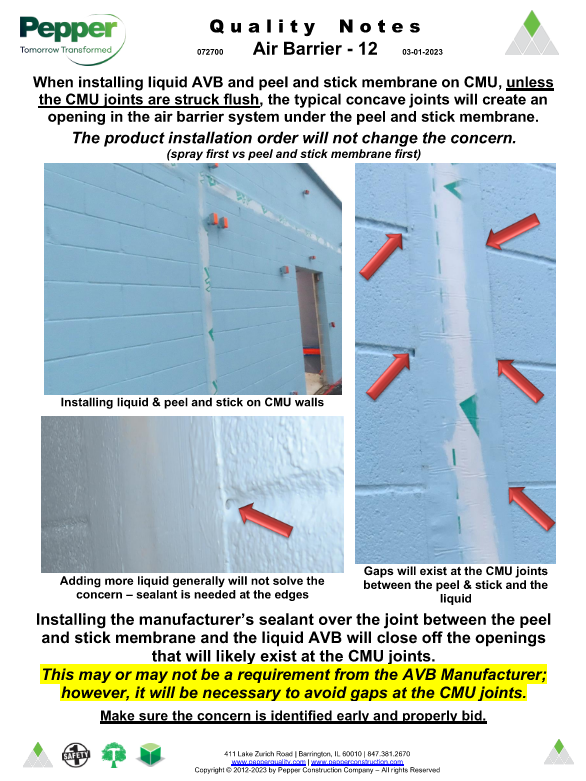
Air Barrier 12 CMU CJ Detailing - QN
- Corey S Zussman, AIA
- Link
When installing liquid AVB and peel and stick membrane on CMU, unless the CMU joints are struck flush, the typical concave joints will create an opening in the air barrier system under the peel and stick membrane. The product installation order will not change the concern (spray first vs peel and stick membrane first). Installing the manufacturer’s sealant over the joint between the peel and stick membrane and the liquid AVB will close off the openings that will likely exist at the CMU joints.
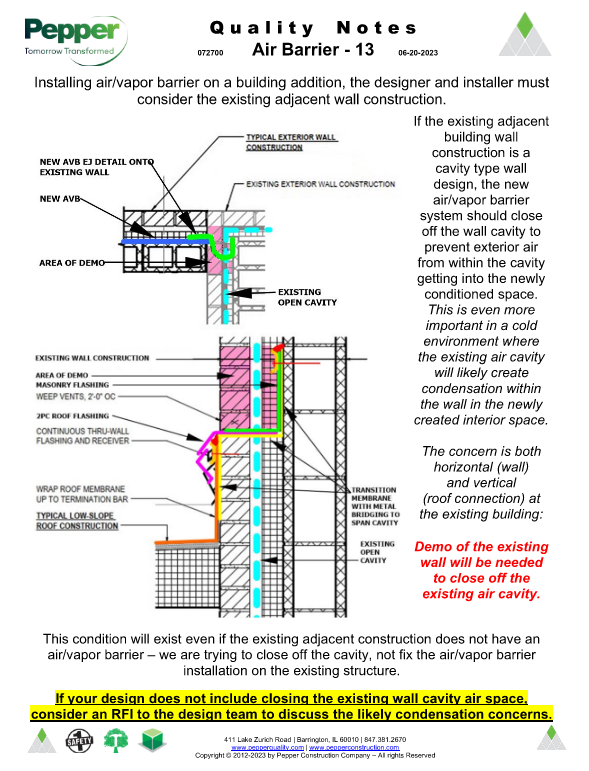
Air Barrier 13 Closing off Existing Walls- QN
- Corey S Zussman, AIA
- Link
Installing air/vapor barrier on a building addition, the designer and installer must consider the existing adjacent wall construction. If the existing adjacent building wall construction is a cavity type wall design, the new air/vapor barrier system should close off the wall cavity to prevent exterior air from within the cavity getting into the newly conditioned space. This is even more important in a cold environment where the existing air cavity will likely create condensation within the wall in the newly created interior space.
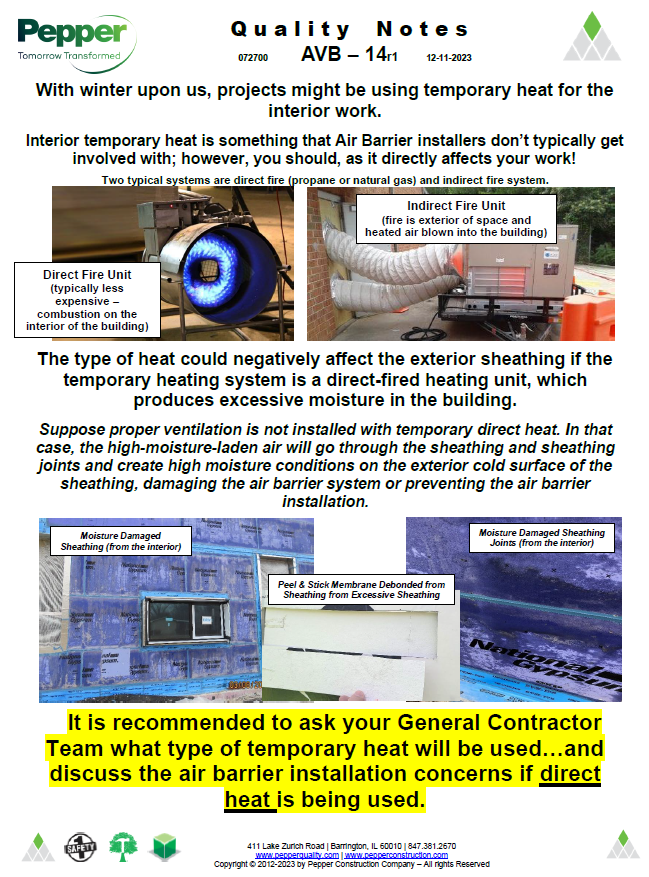
Air Barrier 14r1 Temporary Heat - QN
- Corey S Zussman, AIA
- Link
With winter upon us, projects might be using temporary heat for the interior work. Two typical systems are direct fire (propane or natural gas) and indirect fire system. Direct fire units are similar to a fireplace without a chimney. Indirect units are similar to a home furnace with a flue to the exterior. The Quality Department recommends indirect Heat on most of our projects.
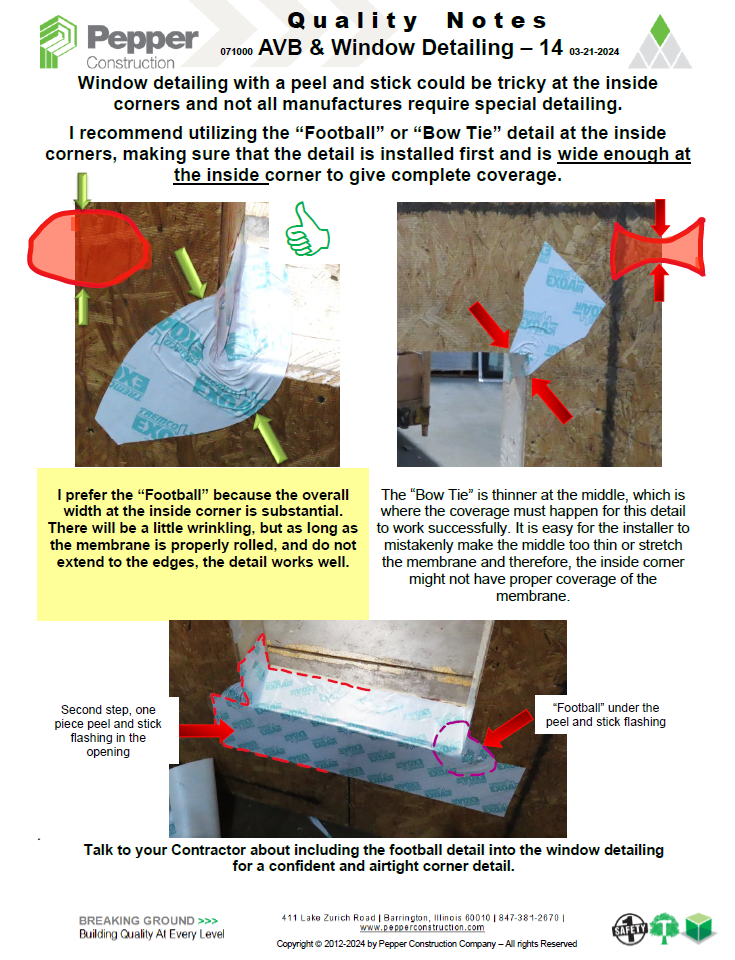
AVB Window Opening Detailing 14 QN
- Corey S Zussman, AIA
- Link
Window detailing with a peel and stick could be tricky at the inside corners and not all manufactures require special detailing. I recommend utilizing the “Football” or “Bow Tie” detail at the inside corners, making sure that the detail is installed first and is wide enough at the inside corner to give complete coverage. Talk to your Contractor about including the football detail into the window detailing for a confident and airtight corner detail.
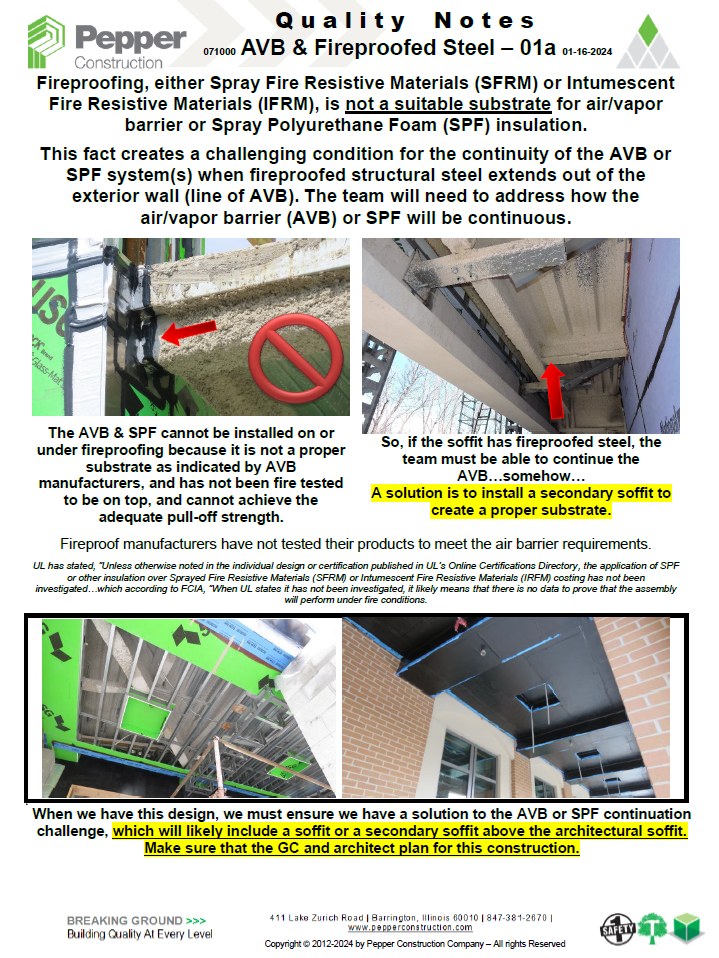
AVB Fireproofing Steel in Soffit- 01a - QN
- Corey S Zussman, AIA
- Link
Fireproofing, either Spray Fire Resistive Materials (SFRM) or Intumescent Fire Resistive Materials (IFRM), is not a suitable substrate for air/vapor barrier or Spray Polyurethane Foam (SPF) insulation. This fact creates a challenging condition for the continuity of the AVB or SPF system(s) when fireproofed structural steel extends out of the exterior wall (line of AVB). The team will need to address how the air/vapor barrier (AVB) or SPF will be continuous.
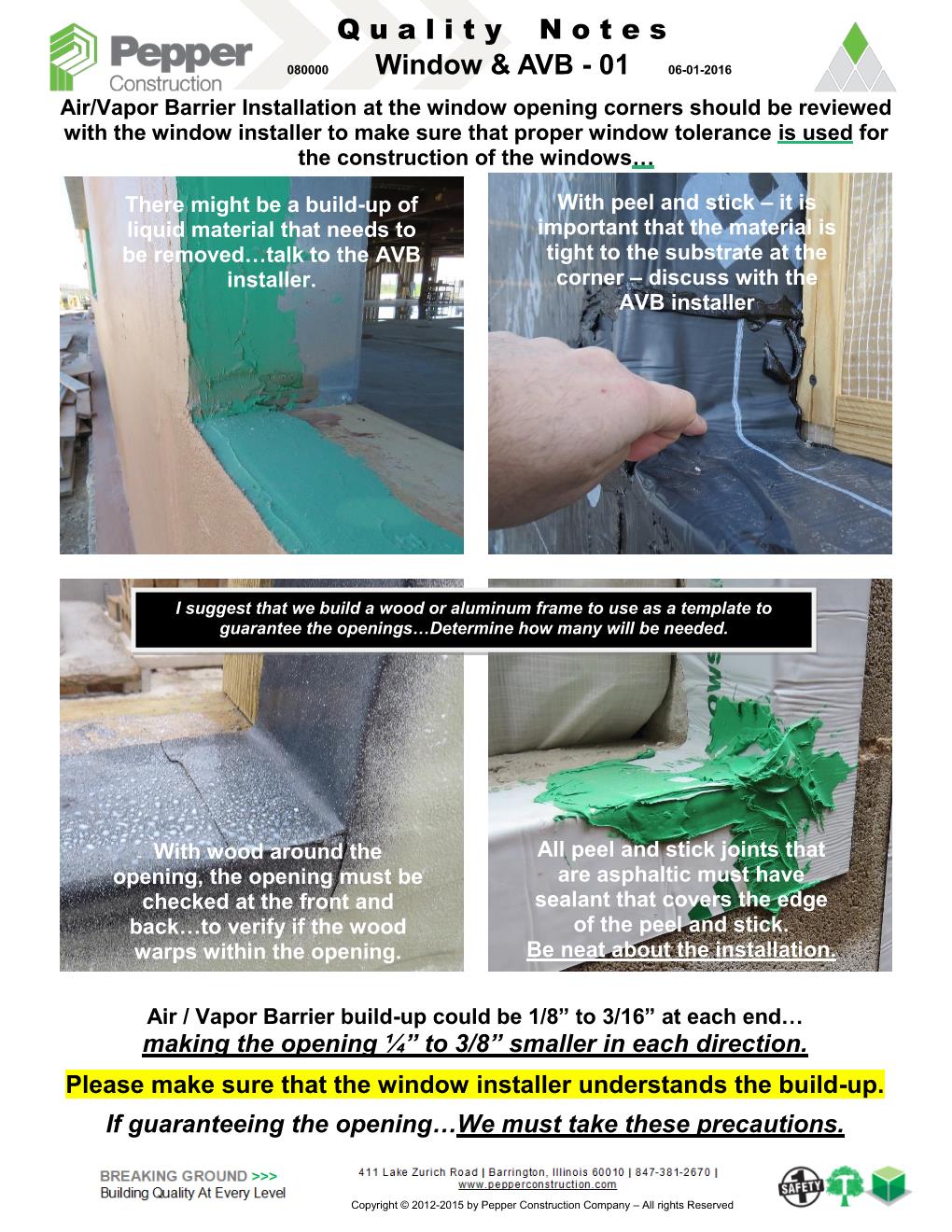
Air Barrier and Window Detailing QN
- Corey S Zussman, AIA
- Link
Air/Vapor Barrier Installation at the window opening corners should be reviewed with the window installer to make sure that proper window tolerance is used for the construction of the windows…
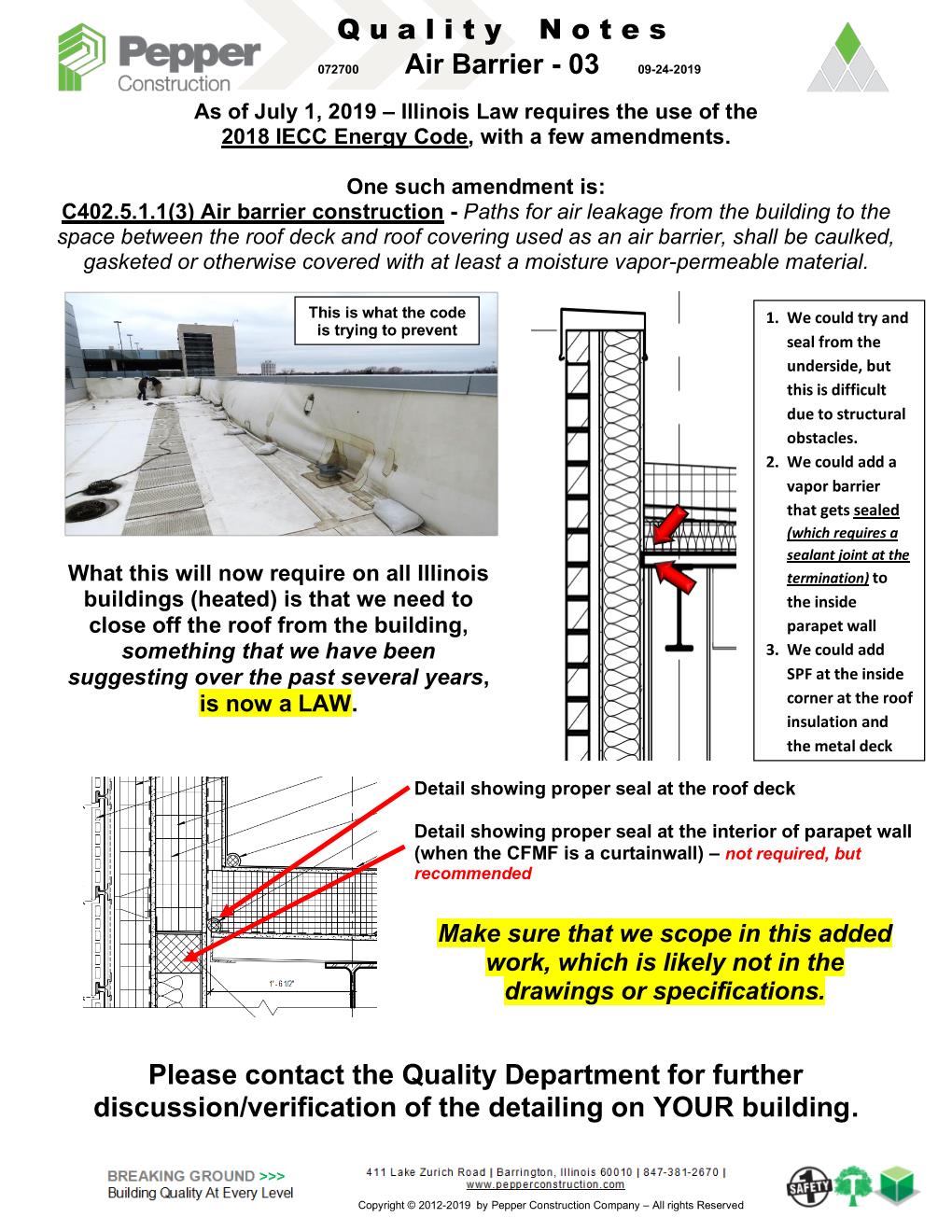
Roof AVB Requirement to Close off the Cavity QN
- Corey S Zussman, AIA
- Link
As of July 1, 2019 – Illinois Law requires the use of the 2018 IECC Energy Code, with a few amendments. One such amendment is: C402.5.1.1(3) Air barrier construction - Paths for air leakage from the building to the space between the roof deck and roof covering used as an air barrier, shall be caulked, gasketed or otherwise covered with at least a moisture vapor-permeable material.
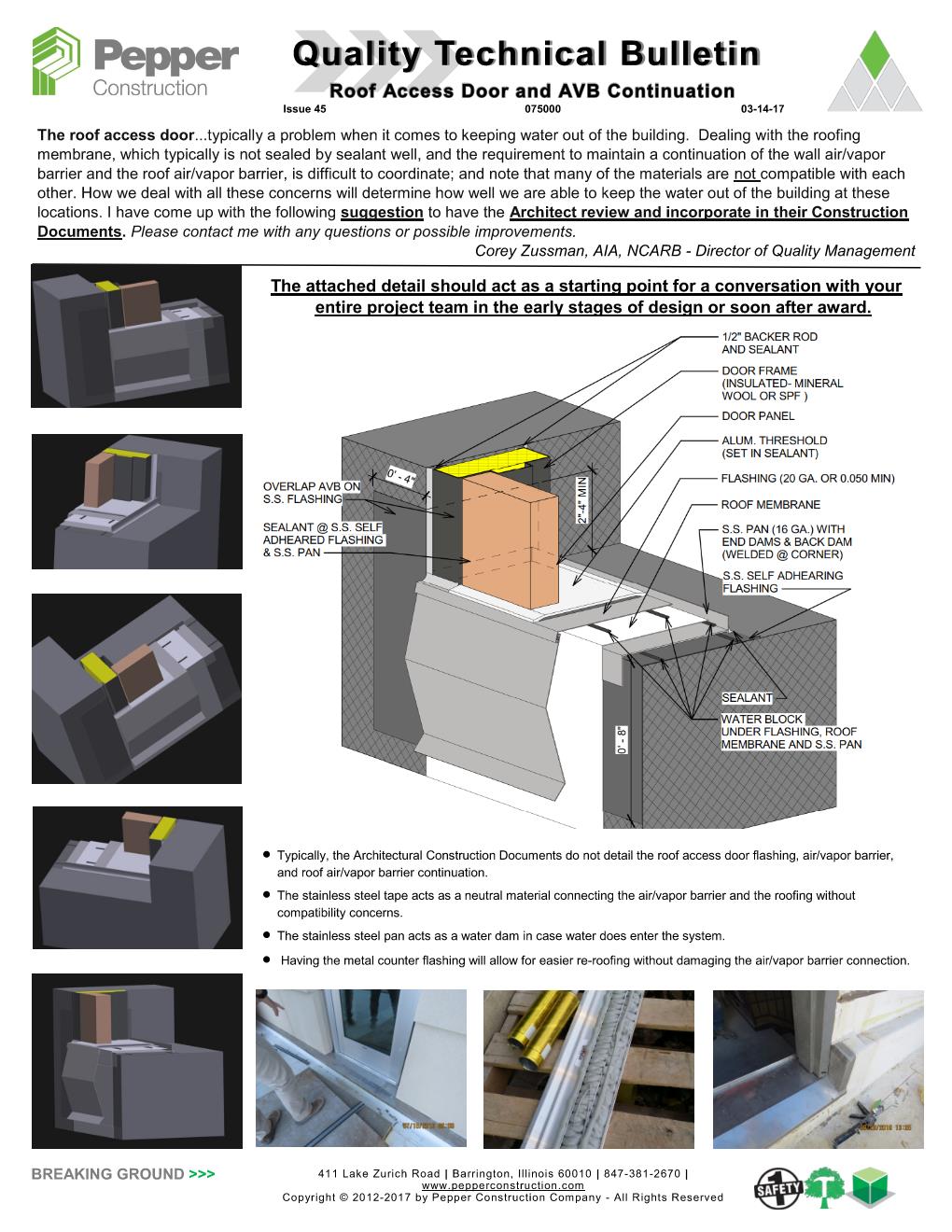
Roof Access Door Sill Detailing Issue 45
- Corey S Zussman, AIA
- Link
The roof access door ...typically a problem when it comes to keeping water out of the building. Dealing with the roofing membrane, which typically is not sealed by sealant well, and the requirement to maintain a continuation of the wall air/vapor barrier and the roof air/vapor barrier, is difficult to coordinate; and note that many of the materials are not compatible with each other. How we deal with all these concerns will determine how well we are able to keep the water out of the building at these locations. I have come up with the following suggestion to have the Architect review and incorporate in their Construction Documents. Please contact me with any questions or possible improvements.
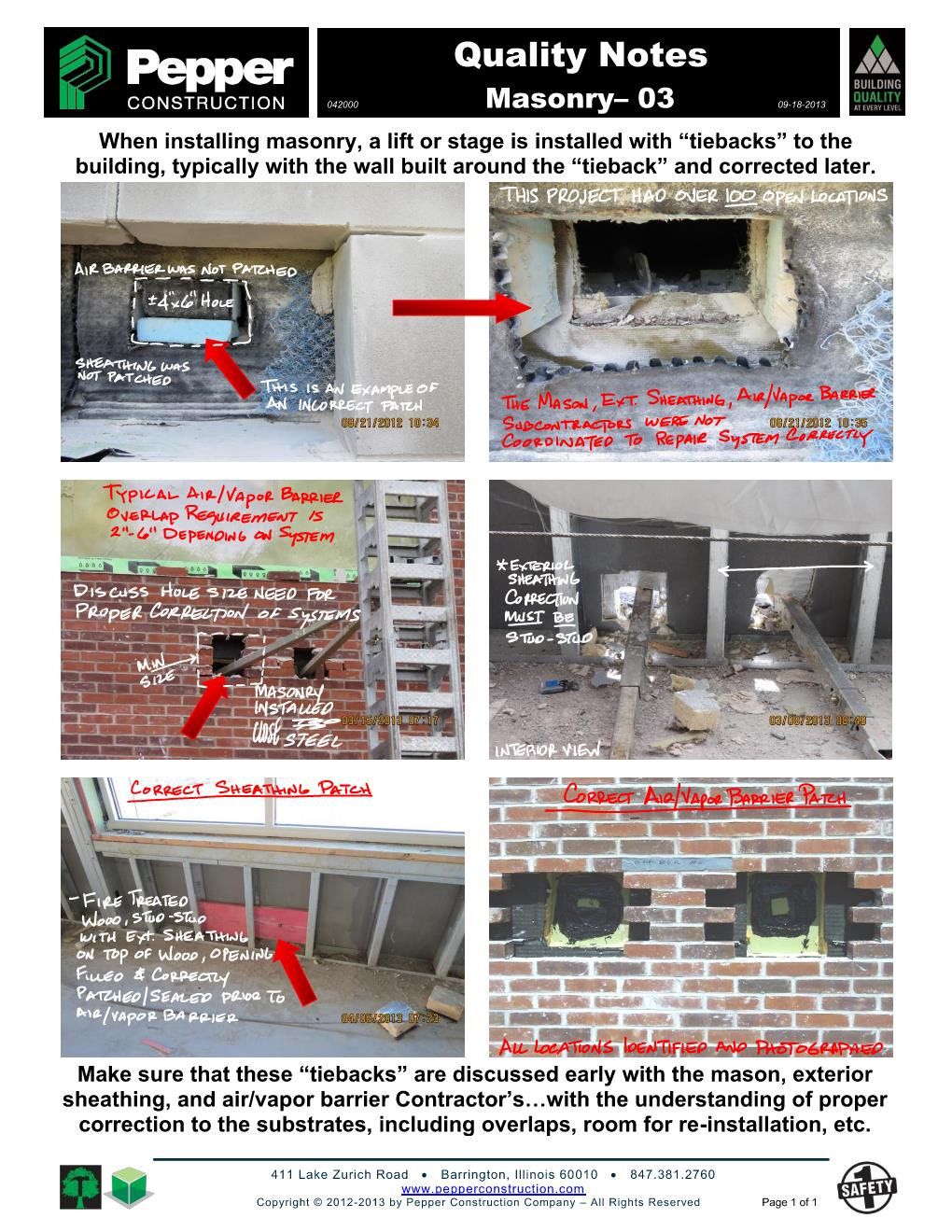
Masonry 03 Tie Back- QN
- Corey S Zussman, AIA
- Link
When installing masonry, a lift or stage is installed with “tiebacks” to the building, typically with the wall built around the “tieback” and corrected later.
